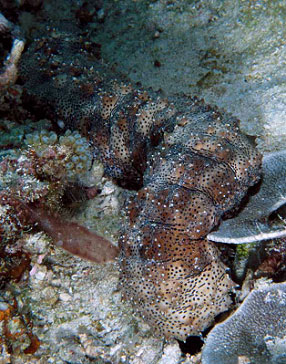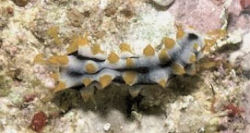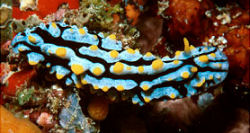Sea cucumber, Pearsonothuria graeffei

Pearsonothuria graeffei is a member of the most diverse family of sea cucumbers on coral reefs, the Holothuriidae. Previously, it was considered a species of the genus Bohadschia, but was recently placed into its own genus,Pearsonothuria, because of its distinctly different chemical characteristics.
Most sea cucumbers in the tropics retain a chemical cocktail of steroid glycosides in different regions of the body (depending on the species), and some of these are neuro-toxins. The effect on certain animals exposed to these toxic steroid glycosides is like cocaine; it blocks the transmission of nerve impulses. Members of Pearsonothuriahave a high level of toxic glycosides in their Cuverian Tubules. It is unknown how the chemistry affects humans, but it is theorized that it could have medicinal applications as a painkiller or an anti-tumor agent. This sea cucumber is uncommonly but easily seen out in the open on many coral reefs ranging from the West Indian Ocean to the West Pacific Ocean. Many members of the family to which it belongs have a unique idiosyncrasy of discharging Cuverian Tubules (specialized intestinal diverticula) from their anus as a defense mechanism. Some species actually aim their rear ends toward the threat and shoot out these sticky white strands, entangling and demobilizing the menace.
Pearsonothuria graeffei is unusual in that it will choose to discharge its tubules only if it’s highly distressed; in contrast species of Bohadschia discharge them under the slightest provocation. Many sea cucumbers, also known as beche-de-mer or trepang to consumers, are eaten in the Indo West Pacific; they are prepared for sale by drying or smoking the body wall. This animal is not valuable in this respect, however, because it has a thin body wall and a high composition of toxins. The most remarkable feature ofPearsonothuria graffei is its life history. As it grows, it goes through a transformation from a vividly colored juvenile of yellow and dark blue or black, to a full grown adult colored in beige and brown with black dots. The small and vulnerable juvenile evolved the adaptation to mimic an aposematic (brightly colored to denote toxicity) phyllidiid sea slug, Phyllidia varicosa. Once it grows to a size in which the mimicry becomes ineffective and its large size combined with more mild toxicity become more effective defenses, it begins to change its appearance.

